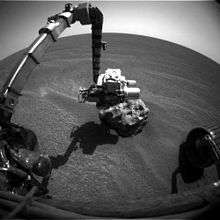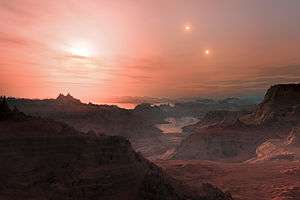Curiosity (rover)
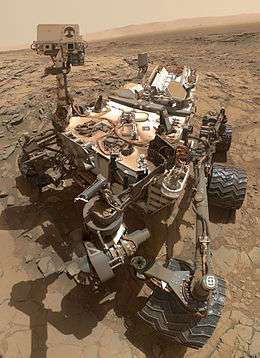 Self-portrait of Curiosity located at the foothill of Mount Sharp (October 6, 2015) | |||||
| Mission type | Mars rover | ||||
|---|---|---|---|---|---|
| Operator | NASA | ||||
| COSPAR ID | 2011-070A | ||||
| SATCAT № | 37936 | ||||
| Website |
mars | ||||
| Mission duration |
Primary: 668 sols (687 days) Current: 1543 sols (1585 days) since landing[1] | ||||
| Spacecraft properties | |||||
| Manufacturer | |||||
| Dry mass | Rover only: 899 kg (1,982 lb)[2] | ||||
| Start of mission | |||||
| Launch date | November 26, 2011, 15:02:00 UTC[3][4][5] | ||||
| Rocket | Atlas V 541 (AV-028) | ||||
| Launch site | Cape Canaveral LC-41[6] | ||||
| Orbital parameters | |||||
| Reference system | Heliocentric (transfer) | ||||
| Mars rover | |||||
| Spacecraft component | Rover | ||||
| Landing date |
August 6, 2012, 05:17:57 UTC SCET[3][7] MSD 49269 05:53:28 AMT | ||||
| Landing site |
Aeolis Palus ("Bradbury Landing"[8]) in Gale Crater (4°35′22″S 137°26′30″E / 4.5895°S 137.4417°E)[9][10] | ||||
| Distance covered |
14.14 km (8.79 mi)[11] as of 8 September 2016 | ||||
| |||||
Curiosity is a car-sized robotic rover exploring Gale Crater on Mars as part of NASA's Mars Science Laboratory mission (MSL).[3] As of December 8, 2016, Curiosity has been on Mars for 1543 sols (1585 total days) since landing on August 6, 2012. (See current status.)
Curiosity was launched from Cape Canaveral on November 26, 2011, at 15:02 UTC aboard the MSL spacecraft and landed on Aeolis Palus in Gale Crater on Mars on August 6, 2012, 05:17 UTC.[1][12] The Bradbury Landing site was less than 2.4 km (1.5 mi) from the center of the rover's touchdown target after a 563,000,000 km (350,000,000 mi) journey.[8][13]
The rover's goals include: investigation of the Martian climate and geology; assessment of whether the selected field site inside Gale Crater has ever offered environmental conditions favorable for microbial life, including investigation of the role of water; and planetary habitability studies in preparation for future human exploration.[14][15]
Curiosity's design will serve as the basis for the planned Mars 2020 rover. In December 2012, Curiosity's two-year mission was extended indefinitely.[16]
Goals and objectives
As established by the Mars Exploration Program, the main scientific goals of the MSL mission are to help determine whether Mars could ever have supported life, as well as determining the role of water, and to study the climate and geology of Mars.[14][15] The mission will also help prepare for human exploration.[15] To contribute to these goals, MSL has eight main scientific objectives:[17]
- Biological
- Determine the nature and inventory of organic carbon compounds
- Investigate the chemical building blocks of life (carbon, hydrogen, nitrogen, oxygen, phosphorus, and sulfur)
- Identify features that may represent the effects of biological processes (biosignatures and biomolecules)
- Geological and geochemical
- Investigate the chemical, isotopic, and mineralogical composition of the Martian surface and near-surface geological materials
- Interpret the processes that have formed and modified rocks and soils
- Planetary process
- Assess long-timescale (i.e., 4-billion-year) Martian atmospheric evolution processes
- Determine present state, distribution, and cycling of water and carbon dioxide
- Surface radiation
- Characterize the broad spectrum of surface radiation, including galactic and cosmic radiation, solar proton events and secondary neutrons. As part of its exploration, it also measured the radiation exposure in the interior of the spacecraft as it traveled to Mars, and it is continuing radiation measurements as it explores the surface of Mars. This data would be important for a future manned mission.[18]
About one year into the surface mission, and having assessed that ancient Mars could have been hospitable to microbial life, the MSL mission objectives evolved to developing predictive models for the preservation process of organic compounds and biomolecules; a branch of paleontology called taphonomy.[19]
Specifications
Curiosity comprised 23 percent of the mass of the 3,893 kg (8,583 lb) Mars Science Laboratory (MSL) spacecraft, which had the sole mission of delivering the rover safely across space from Earth to a soft landing on the surface of Mars. The remaining mass of the MSL craft was discarded in the process of carrying out this task.
- Dimensions: Curiosity has a mass of 899 kg (1,982 lb) including 80 kg (180 lb) of scientific instruments.[20] The rover is 2.9 m (9.5 ft) long by 2.7 m (8.9 ft) wide by 2.2 m (7.2 ft) in height.[21]
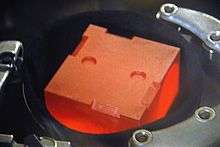
- Power source: Curiosity is powered by a radioisotope thermoelectric generator (RTG), like the successful Viking 1 and Viking 2 Mars landers in 1976.[22][23]
- Radioisotope power systems (RPSs) are generators that produce electricity from the decay of radioactive isotopes, such as plutonium-238, which is a non-fissile isotope of plutonium. Heat given off by the decay of this isotope is converted into electric voltage by thermocouples, providing constant power during all seasons and through the day and night. Waste heat can be used via pipes to warm systems, freeing electrical power for the operation of the vehicle and instruments.[22][23] Curiosity's RTG is fueled by 4.8 kg (11 lb) of plutonium-238 dioxide supplied by the U.S. Department of Energy.[24]
- Curiosity is powered by a Multi-Mission Radioisotope Thermoelectric Generator (MMRTG), designed and built by Rocketdyne and Teledyne Energy Systems under contract to the U.S. Department of Energy,[25][26] and assembled and tested by the Idaho National Laboratory.[27] Based on legacy RTG technology, it represents a more flexible and compact development step,[28] and is designed to produce 125 watts of electrical power from about 2,000 watts of thermal power at the start of the mission.[22][23] The MMRTG produces less power over time as its plutonium fuel decays: at its minimum lifetime of 14 years, electrical power output is down to 100 watts.[29][30] The power source will generate 9 MJ (2.5 kWh) each day, much more than the solar panels of the Mars Exploration Rovers, which can generate about 2.1 MJ (0.58 kWh) each day. The electrical output from the MMRTG charges two rechargeable lithium-ion batteries. This enables the power subsystem to meet peak power demands of rover activities when the demand temporarily exceeds the generator’s steady output level. Each battery has a capacity of about 42 ampere-hours.
- Heat rejection system: The temperatures at the landing site can vary from −127 to 40 °C (−197 to 104 °F); therefore, the thermal system will warm the rover for most of the Martian year. The thermal system will do so in several ways: passively, through the dissipation to internal components; by electrical heaters strategically placed on key components; and by using the rover heat rejection system (HRS).[31] It uses fluid pumped through 60 m (200 ft) of tubing in the rover body so that sensitive components are kept at optimal temperatures.[32] The fluid loop serves the additional purpose of rejecting heat when the rover has become too warm, and it can also gather waste heat from the power source by pumping fluid through two heat exchangers that are mounted alongside the RTG. The HRS also has the ability to cool components if necessary.[32]
- Computers: The two identical on-board rover computers, called Rover Computer Element (RCE) contain radiation hardened memory to tolerate the extreme radiation from space and to safeguard against power-off cycles. Each computer's memory includes 256 kB of EEPROM, 256 MB of DRAM, and 2 GB of flash memory.[33] For comparison, the Mars Exploration Rovers used 3 MB of EEPROM, 128 MB of DRAM, and 256 MB of flash memory.[34]
- The RCE computers use the RAD750 CPU, which is a successor to the RAD6000 CPU of the Mars Exploration Rovers.[35][36] The RAD750 CPU, a radiation-hardened version of the PowerPC 750, can execute up to 400 MIPS, while the RAD6000 CPU is capable of up to only 35 MIPS.[37][38] Of the two on-board computers, one is configured as backup and will take over in the event of problems with the main computer.[33] On February 28, 2013, NASA was forced to switch to the backup computer due to an issue with the then active computer's flash memory, which resulted in the computer continuously rebooting in a loop. The backup computer was turned on in safe mode and subsequently returned to active status on March 4.[39] The same issue happened in late March, resuming full operations on March 25, 2013.[40]
- The rover has an Inertial Measurement Unit (IMU) that provides 3-axis information on its position, which is used in rover navigation.[33] The rover's computers are constantly self-monitoring to keep the rover operational, such as by regulating the rover's temperature.[33] Activities such as taking pictures, driving, and operating the instruments are performed in a command sequence that is sent from the flight team to the rover.[33] The rover installed its full surface operations software after the landing because its computers did not have sufficient main memory available during flight. The new software essentially replaced the flight software.[13]
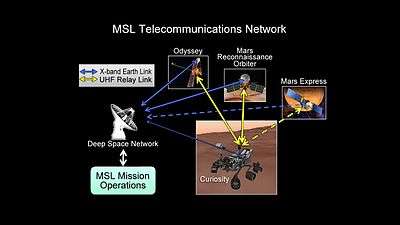
- Communications: Curiosity is equipped with significant telecommunication redundancy by several means – an X band transmitter and receiver that can communicate directly with Earth, and a UHF Electra-Lite software-defined radio for communicating with Mars orbiters.[31] Communication with orbiters is expected to be the main path for data return to Earth, since the orbiters have both more power and larger antennas than the lander allowing for faster transmission speeds.[31] Telecommunication includes a small deep space transponder on the descent stage and a solid-state power amplifier on the rover for X band. The rover also has two UHF radios,[31] the signals of which the 2001 Mars Odyssey satellite is capable of relaying back to Earth. An average of 14 minutes, 6 seconds will be required for signals to travel between Earth and Mars.[41] Curiosity can communicate with Earth directly at speeds up to 32 kbit/s, but the bulk of the data transfer should be relayed through the Mars Reconnaissance Orbiter and Odyssey orbiter. Data transfer speeds between Curiosity and each orbiter may reach 2000 kbit/s and 256 kbit/s, respectively, but each orbiter is able to communicate with Curiosity for only about eight minutes per day (0.56% of the time).[42] Communication from and to Curiosity relies on internationally agreed space data communications protocols as defined by the Consultative Committee for Space Data Systems.[43]
- JPL is the central data distribution hub where selected data products are provided to remote science operations sites as needed. JPL is also the central hub for the uplink process, though participants are distributed at their respective home institutions.[31] At landing, telemetry was monitored by three orbiters, depending on their dynamic location: the 2001 Mars Odyssey, Mars Reconnaissance Orbiter and ESA's Mars Express satellite.[44]
- Mobility systems: Curiosity is equipped with six 50 cm (20 in) diameter wheels in a rocker-bogie suspension. The suspension system also served as landing gear for the vehicle, unlike its smaller predecessors.[45][46] Each wheel has cleats and is independently actuated and geared, providing for climbing in soft sand and scrambling over rocks. Each front and rear wheel can be independently steered, allowing the vehicle to turn in place as well as execute arcing turns.[31] Each wheel has a pattern that helps it maintain traction but also leaves patterned tracks in the sandy surface of Mars. That pattern is used by on-board cameras to estimate the distance traveled. The pattern itself is Morse code for "JPL" (·--- ·--· ·-··).[47] The rover is capable of climbing sand dunes with slopes up to 12.5°.[48] Based on the center of mass, the vehicle can withstand a tilt of at least 50° in any direction without overturning, but automatic sensors will limit the rover from exceeding 30° tilts.[31] After two years of use, the wheels are visibly worn with punctures and tears.[49]
- Curiosity can roll over obstacles approaching 65 cm (26 in) in height,[50] and it has a ground clearance of 60 cm (24 in).[51] Based on variables including power levels, terrain difficulty, slippage and visibility, the maximum terrain-traverse speed is estimated to be 200 m (660 ft) per day by automatic navigation.[50] The rover landed about 10 km (6.2 mi) from the base of Mount Sharp,[52] (officially named Aeolis Mons) and it is expected to traverse a minimum of 19 km (12 mi) during its primary two-year mission.[53] It can travel up to 90 metres (300 ft) per hour but average speed is about 30 metres (98 ft) per hour.[53]
Instruments
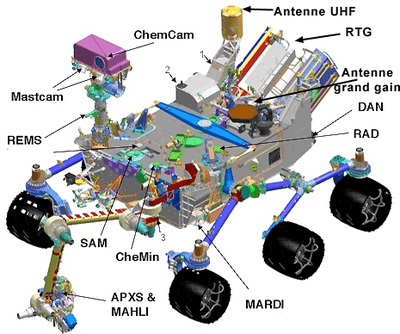
The general sample analysis strategy begins with high-resolution cameras to look for features of interest. If a particular surface is of interest, Curiosity can vaporize a small portion of it with an infrared laser and examine the resulting spectra signature to query the rock's elemental composition. If that signature is intriguing, the rover will use its long arm to swing over a microscope and an X-ray spectrometer to take a closer look. If the specimen warrants further analysis, Curiosity can drill into the boulder and deliver a powdered sample to either the SAM or the CheMin analytical laboratories inside the rover.[54][55][56] The MastCam, Mars Hand Lens Imager (MAHLI), and Mars Descent Imager (MARDI) cameras were developed by Malin Space Science Systems and they all share common design components, such as on-board electronic imaging processing boxes, 1600×1200 CCDs, and an RGB Bayer pattern filter.[57][58][59][60][61][62]
It has 17 cameras: HazCams (8), NavCams (4), MastCams (2), MAHLI (1), MARDI (1), and ChemCam (1).[63]
Mast Camera (MastCam)
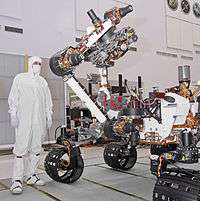
The MastCam system provides multiple spectra and true-color imaging with two cameras.[58] The cameras can take true-color images at 1600×1200 pixels and up to 10 frames per second hardware-compressed video at 720p (1280×720).[64]
One MastCam camera is the Medium Angle Camera (MAC), which has a 34 mm (1.3 in) focal length, a 15° field of view, and can yield 22 cm/pixel (8.7 in/pixel) scale at 1 km (0.62 mi). The other camera in the MastCam is the Narrow Angle Camera (NAC), which has a 100 mm (3.9 in) focal length, a 5.1° field of view, and can yield 7.4 cm/pixel (2.9 in/pixel) scale at 1 km (0.62 mi).[58] Malin also developed a pair of MastCams with zoom lenses,[65] but these were not included in the rover because of the time required to test the new hardware and the looming November 2011 launch date.[66] However, the improved zoom version was selected to be incorporated on the upcoming Mars 2020 mission as Mastcam-Z.[67]
Each camera has eight gigabytes of flash memory, which is capable of storing over 5,500 raw images, and can apply real time lossless data compression.[58] The cameras have an autofocus capability that allows them to focus on objects from 2.1 m (6 ft 11 in) to infinity.[61] In addition to the fixed RGBG Bayer pattern filter, each camera has an eight-position filter wheel. While the Bayer filter reduces visible light throughput, all three colors are mostly transparent at wavelengths longer than 700 nm, and have minimal effect on such infrared observations.[58]
Chemistry and Camera complex (ChemCam)

ChemCam is a suite of remote sensing instruments, and as the name implies, ChemCam is actually two different instruments combined as one: a laser-induced breakdown spectroscopy (LIBS) and a Remote Micro Imager (RMI) telescope. The ChemCam instrument suite was developed by the French CESR laboratory and the Los Alamos National Laboratory .[68][69][70] The flight model of the mast unit was delivered from the French CNES to Los Alamos National Laboratory.[71] The purpose of the LIBS instrument is to provide elemental compositions of rock and soil, while the RMI will give ChemCam scientists high-resolution images of the sampling areas of the rocks and soil that LIBS targets.[68][72] The LIBS instrument can target a rock or soil sample up to 7 m (23 ft) away, vaporizing a small amount of it with about 50 to 75 5-nanosecond pulses from a 1067 nm infrared laser and then observing the spectrum of the light emitted by the vaporized rock.[73]

ChemCam has the ability to record up to 6,144 different wavelengths of ultraviolet, visible, and infrared light.[74] Detection of the ball of luminous plasma will be done in the visible, near-UV and near-infrared ranges, between 240 nm and 800 nm.[68] The first initial laser testing of the ChemCam by Curiosity on Mars was performed on a rock, N165 ("Coronation" rock), near Bradbury Landing on August 19, 2012.[75][76][77] The ChemCam team expects to take approximately one dozen compositional measurements of rocks per day.[78]
Using the same collection optics, the RMI provides context images of the LIBS analysis spots. The RMI resolves 1 mm (0.039 in) objects at 10 m (33 ft) distance, and has a field of view covering 20 cm (7.9 in) at that distance.[68]
Navigation cameras (navcams)
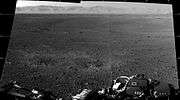
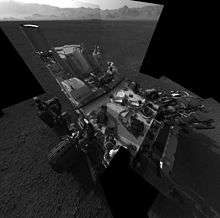
The rover has two pairs of black and white navigation cameras mounted on the mast to support ground navigation.[79][80] The cameras have a 45° angle of view and use visible light to capture stereoscopic 3-D imagery.[80][81]
Rover Environmental Monitoring Station (REMS)
REMS comprises instruments to measure the Mars environment: humidity, pressure, temperatures, wind speeds, and ultraviolet radiation.[82] It is a meteorological package that includes an ultraviolet sensor provided by the Spanish Ministry of Education and Science. The investigative team is led by Javier Gómez-Elvira of the Center for Astrobiology (Madrid) and includes the Finnish Meteorological Institute as a partner.[83][84] All sensors are located around three elements: two booms attached to the rover's mast, the Ultraviolet Sensor (UVS) assembly located on the rover top deck, and the Instrument Control Unit (ICU) inside the rover body. REMS will provide new clues about the Martian general circulation, micro scale weather systems, local hydrological cycle, destructive potential of UV radiation, and subsurface habitability based on ground-atmosphere interaction.[83]
Hazard avoidance cameras (hazcams)
The rover has four pairs of black and white navigation cameras called hazcams, two pairs in the front and two pairs in the back.[79][85] They are used for autonomous hazard avoidance during rover drives and for safe positioning of the robotic arm on rocks and soils.[85] Each camera in a pair is hardlinked to one of two identical main computers for redundancy; only four out of the eight cameras are in use at any one time. The cameras use visible light to capture stereoscopic three-dimensional (3-D) imagery.[85] The cameras have a 120° field of view and map the terrain at up to 3 m (9.8 ft) in front of the rover.[85] This imagery safeguards against the rover crashing into unexpected obstacles, and works in tandem with software that allows the rover to make its own safety choices.[85]
Mars Hand Lens Imager (MAHLI)
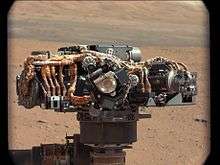
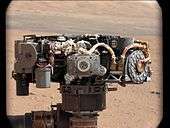
MAHLI is a camera on the rover's robotic arm, and acquires microscopic images of rock and soil. MAHLI can take true-color images at 1600×1200 pixels with a resolution as high as 14.5 micrometers per pixel. MAHLI has an 18.3 to 21.3 mm (0.72 to 0.84 in) focal length and a 33.8–38.5° field of view.[59] MAHLI has both white and ultraviolet LED illumination for imaging in darkness or fluorescence imaging. MAHLI also has mechanical focusing in a range from infinite to millimetre distances.[59] This system can make some images with focus stacking processing.[86] MAHLI can store either the raw images or do real time lossless predictive or JPEG compression. The calibration target for MAHLI includes color references, a metric bar graphic, a 1909 VDB Lincoln penny, and a stairstep pattern for depth calibration.[87]
Alpha Particle X-ray Spectrometer (APXS)
The device irradiates samples with alpha particles and maps the spectra of X-rays that are re-emitted for determining the elemental composition of samples.[88] Curiosity's APXS was developed by the Canadian Space Agency.[88] MacDonald Dettwiler (MDA), the Canadian aerospace company that built the Canadarm and RADARSAT, were responsible for the engineering design and building of the APXS. The APXS science team includes members from the University of Guelph, the University of New Brunswick, the University of Western Ontario, NASA, the University of California, San Diego and Cornell University.[89] The APXS instrument takes advantage of particle-induced X-ray emission (PIXE) and X-ray fluorescence, previously exploited by the Mars Pathfinder and the Mars Exploration Rovers.[88][90]
Chemistry and Mineralogy (CheMin)
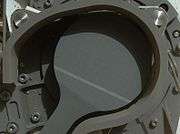
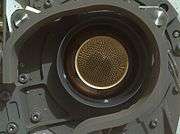
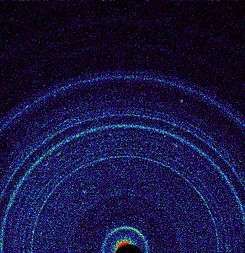
CheMin is the Chemistry and Mineralogy X-ray powder diffraction and fluorescence instrument.[92] CheMin is one of four spectrometers. It can identify and quantify the abundance of the minerals on Mars. It was developed by David Blake at NASA Ames Research Center and the Jet Propulsion Laboratory,[93] and won the 2013 NASA Government Invention of the year award.[94] The rover can drill samples from rocks and the resulting fine powder is poured into the instrument via a sample inlet tube on the top of the vehicle. A beam of X-rays is then directed at the powder and the crystal structure of the minerals deflects it at characteristic angles, allowing scientists to identify the minerals being analyzed.[95]
On October 17, 2012, at "Rocknest", the first X-ray diffraction analysis of Martian soil was performed. The results revealed the presence of several minerals, including feldspar, pyroxenes and olivine, and suggested that the Martian soil in the sample was similar to the "weathered basaltic soils" of Hawaiian volcanoes.[91] The paragonetic tephra from a Hawaiian cinder cone has been mined to create Martian regolith simulant for researchers to use since 1998.[96][97]
Sample Analysis at Mars (SAM)
The SAM instrument suite analyzes organics and gases from both atmospheric and solid samples. It consists of instruments developed by the NASA Goddard Space Flight Center, the Laboratoire Inter-Universitaire des Systèmes Atmosphériques (LISA) (jointly operated by France's CNRS and Parisian universities), and Honeybee Robotics, along with many additional external partners.[55][98][99] The three main instruments are a Quadrupole Mass Spectrometer (QMS), a gas chromatograph (GC) and a tunable laser spectrometer (TLS). These instruments will perform precision measurements of oxygen and carbon isotope ratios in carbon dioxide (CO2) and methane (CH4) in the atmosphere of Mars in order to distinguish between their geochemical or biological origin.[55][99][100][101][102]
Dust Removal Tool (DRT)
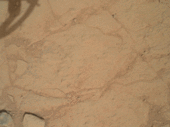

The Dust Removal Tool (DRT) is a motorized, wire-bristle brush on the turret at the end of Curiosity's arm. The DRT was first used on a rock target named Ekwir_1 on January 6, 2013. Honeybee Robotics built the DRT.[103]
Radiation assessment detector (RAD)
This instrument was the first of ten MSL instruments to be turned on. Its first role was to characterize the broad spectrum of radiation environment found inside the spacecraft during the cruise phase. These measurements have never been done before from the inside of a spacecraft in interplanetary space. Its primary purpose is to determine the viability and shielding needs for potential human explorers, as well as to characterize the radiation environment on the surface of Mars, which it started doing immediately after MSL landed in August 2012.[104] Funded by the Exploration Systems Mission Directorate at NASA Headquarters and Germany's Space Agency (DLR), RAD was developed by Southwest Research Institute (SwRI) and the extraterrestrial physics group at Christian-Albrechts-Universität zu Kiel, Germany.[104][105]
Dynamic Albedo of Neutrons (DAN)
A pulsed sealed-tube neutron source[106] and detector for measuring hydrogen or ice and water at or near the Martian surface, provided by the Russian Federal Space Agency,[107][108] and funded by Russia.[109]
Mars Descent Imager (MARDI)
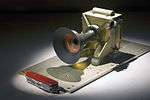
During the descent to the Martian surface, MARDI took color images at 1600×1200 pixels with a 1.3-millisecond exposure time starting at distances of about 3.7 km (2.3 mi) to near 5 m (16 ft) from the ground, at a rate of four frames per second for about two minutes.[60][110] MARDI has a pixel scale of 1.5 m (4.9 ft) at 2 km (1.2 mi) to 1.5 mm (0.059 in) at 2 m (6.6 ft) and has a 90° circular field of view. MARDI has eight gigabytes of internal buffer memory that is capable of storing over 4,000 raw images. MARDI imaging allowed the mapping of surrounding terrain and the location of landing.[60] JunoCam, built for the Juno spacecraft, is based on MARDI.[111]
Robotic arm
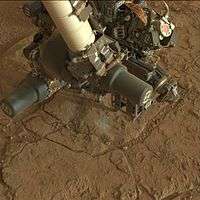
The rover has a 2.1 m (6.9 ft) long robotic arm with a cross-shaped turret holding five devices that can spin through a 350° turning range.[113][114] The arm makes use of three joints to extend it forward and to stow it again while driving. It has a mass of 30 kg (66 lb) and its diameter, including the tools mounted on it, is about 60 cm (24 in).[115] It was designed, built, and tested by MDA US Systems, building upon their prior robotic arm work on the Mars Surveyor 2001 Lander, the Mars Phoenix (spacecraft), and the two Mars Exploration Rovers, Spirit and Opportunity.[116]
Two of the five devices are in-situ or contact instruments known as the X-ray spectrometer (APXS), and the Mars Hand Lens Imager (MAHLI camera). The remaining three are associated with sample acquisition and sample preparation functions: a percussion drill; a brush; and mechanisms for scooping, sieving, and portioning samples of powdered rock and soil.[113][115] The diameter of the hole in a rock after drilling is 1.6 cm (0.63 in) and up to 5 cm (2.0 in) deep.[114][117] The drill carries two spare bits.[117][118] The rover's arm and turret system can place the APXS and MAHLI on their respective targets, and also obtain powdered sample from rock interiors, and deliver them to the SAM and CheMin analyzers inside the rover.[114]
Comparisons

Curiosity has an advanced payload of scientific equipment on Mars.[50] It is the fourth NASA unmanned surface rover sent to Mars since 1996. Previous successful Mars rovers are Sojourner from the Mars Pathfinder mission (1997), and Spirit (2004–2010) and Opportunity (2004–present) rovers from the Mars Exploration Rover mission.
Curiosity is 2.9 m (9.5 ft) long by 2.7 m (8.9 ft) wide by 2.2 m (7.2 ft) in height,[21] larger than Mars Exploration Rovers, which are 1.5 m (4.9 ft) long and have a mass of 174 kg (384 lb) including 6.8 kg (15 lb) of scientific instruments.[20][119][120] In comparison to Pancam on the Mars Exploration Rovers, the MastCam-34 has 1.25× higher spatial resolution and the MastCam-100 has 3.67× higher spatial resolution.[61]
The region the rover is set to explore has been compared to the Four Corners region of the North American west.[121] Gale Crater has an area similar to Connecticut and Rhode Island combined.[122]
Colin Pillinger, leader of the Beagle 2 project, reacted emotionally to the large number of technicians monitoring Curiosity's descent, because Beagle 2 had only four people monitoring it.[123] The Beagle 2 team made a virtue out of necessity; it was known that there was no chance of obtaining funds in Europe, at that time, of the scale previously considered necessary for a Mars rover, so the team used innovative methods to reduce the cost to less than 4% of the cost of the Curiosity mission. They also had only one shot, with no funding for repeat missions (it was named Beagle 2 as a successor to HMS Beagle, not to an earlier rover).[123] It was considered a large risk, and, although Beagle 2 did successfully survive its entry, descent, and landing, incomplete deployment of the solar panels hampered communication back to Earth.[124] The team has proposed that a future launch might take multiple low-cost Beagle-type landers, with a realistic expectation that the vast majority would be successful, allowing exploration of several parts of Mars and possibly asteroids, all for considerably less cost than a single "normal" rover expedition.[125]
Landing
Landing site
Curiosity landed in Quad 51 (nicknamed Yellowknife) of Aeolis Palus in Gale Crater.[126][127][128][129] The landing site coordinates are: 4°35′22″S 137°26′30″E / 4.5895°S 137.4417°E.[9][10] The location has been named Bradbury Landing in honor of science fiction author Ray Bradbury.[8] Gale crater, an estimated 3.5 to 3.8 billion-year-old impact crater, is hypothesized to have first been gradually filled in by sediments; first water-deposited, and then wind-deposited, possibly until it was completely covered. Wind erosion then scoured out the sediments, leaving an isolated 5.5-kilometer-high (3.4 mi) mountain, Aeolis Mons ("Mount Sharp"), at the center of the 154 km (96 mi) wide crater. Thus, it is believed that the rover may have the opportunity to study two billion years of Martian history in the sediments exposed in the mountain. Additionally, its landing site is near an alluvial fan, which is hypothesized to be the result of a flow of ground water, either before the deposition of the eroded sediments or else in relatively recent geologic history.[130][131]
According to NASA, an estimated 20,000 to 40,000 heat-resistant bacterial spores were on Curiosity at launch, and as much as 1,000 times that number may not have been counted.[132]

Rover role in the landing system

Previous NASA Mars rovers became active only after the successful entry, descent and landing on the Martian surface. Curiosity, on the other hand, was active when it touched down on the surface of Mars, employing the rover suspension system for the final set-down.[133]
Curiosity transformed from its stowed flight configuration to a landing configuration while the MSL spacecraft simultaneously lowered it beneath the spacecraft descent stage with a 20 m (66 ft) tether from the "sky crane" system to a soft landing—wheels down—on the surface of Mars.[134][135][136][137] After the rover touched down it waited 2 seconds to confirm that it was on solid ground then fired several pyros (small explosive devices) activating cable cutters on the bridle to free itself from the spacecraft descent stage. The descent stage then flew away to a crash landing, and the rover prepared itself to begin the science portion of the mission.[138]
Coverage, cultural impact and legacy
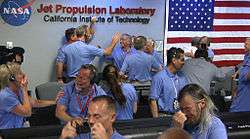

Live video showing the first footage from the surface of Mars was available at NASA TV, during the late hours of August 6, 2012 PDT, including interviews with the mission team. The NASA website momentarily became unavailable from the overwhelming number of people visiting it,[140] and a 13-minute NASA excerpt of the landings on its YouTube channel was halted an hour after the landing by a robotic DMCA takedown notice from Scripps Local News, which prevented access for several hours.[141] Around 1,000 people gathered in New York City's Times Square, to watch NASA's live broadcast of Curiosity's landing, as footage was being shown on the giant screen.[142] Bobak Ferdowsi, Flight Director for the landing, became an Internet meme and attained Twitter celebrity status, with 45,000 new followers subscribing to his Twitter account, due to his Mohawk hairstyle with yellow stars that he wore during the televised broadcast.[143][144]
On August 13, 2012, U.S. President Barack Obama, calling from aboard Air Force One to congratulate the Curiosity team, said, "You guys are examples of American know-how and ingenuity. It's really an amazing accomplishment."[139] (Video (07:20))


Scientists at the Getty Conservation Institute in Los Angeles, California, viewed the CheMin instrument aboard Curiosity as a potentially valuable means to examine ancient works of art without damaging them. Until recently, only a few instruments were available to determine the composition without cutting out physical samples large enough to potentially damage the artifacts. CheMin directs a beam of X-rays at particles as small as 400 micrometres (0.016 in)[145] and reads the radiation scattered back to determine the composition of the artifact in minutes. Engineers created a smaller, portable version named the X-Duetto. Fitting into a few briefcase-sized boxes, it can examine objects on site, while preserving their physical integrity. It is now being used by Getty scientists to analyze a large collection of museum antiques and the Roman ruins of Herculaneum, Italy.[146]
Prior to the landing, NASA and Microsoft released Mars Rover Landing, a free downloadable game on Xbox Live that uses Kinect to capture body motions, which allows users to simulate the landing sequence.[147]
NASA gave the general public the opportunity from 2009 until 2011 to submit their names to be sent to Mars. More than 1.2 million people from the international community participated, and their names were etched into silicon using an electron-beam machine used for fabricating micro devices at JPL, and this plaque is now installed on the deck of Curiosity.[148] In keeping with a 40-year tradition, a plaque with the signatures of President Barack Obama and Vice President Joe Biden was also installed. Elsewhere on the rover is the autograph of Clara Ma, the 12-year-old girl from Kansas who gave Curiosity its name in an essay contest, writing in part that "curiosity is the passion that drives us through our everyday lives."[149]
On August 6, 2013, Curiosity audibly played "Happy Birthday to You" in honor of the one Earth year mark of its Martian landing, the first time for a song to be played on another planet. This was also the first time music was transmitted between two planets.[150]
On June 24, 2014, Curiosity completed a Martian year—687 Earth days—after finding that Mars once had environmental conditions favorable for microbial life.[151] Curiosity will serve as the basis for the design of the Mars 2020 rover mission that is presently planned to be launched to Mars in 2020. Some spare parts from the build and ground test of Curiosity may be used in the new vehicle.[152]
Awards
The NASA/JPL Mars Science Laboratory/Curiosity Project Team was awarded the 2012 Robert J. Collier Trophy by the National Aeronautic Association "In recognition of the extraordinary achievements of successfully landing Curiosity on Mars, advancing the nation's technological and engineering capabilities, and significantly improving humanity's understanding of ancient Martian habitable environments."[153]
Images
| Landing on Mars | ||
|---|---|---|
|
| Components of Curiosity | ||||
|---|---|---|---|---|
|
Aerial images
.png)

 Gale crater - surface materials (false colors; THEMIS; 2001 Mars Odyssey).
Gale crater - surface materials (false colors; THEMIS; 2001 Mars Odyssey).
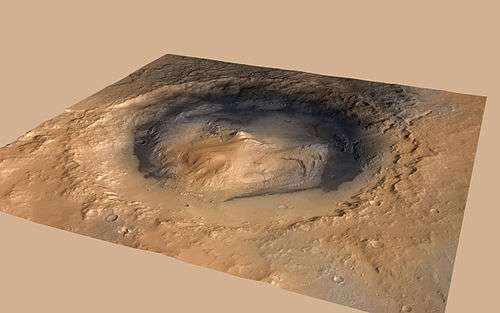 Mount Sharp rises from the middle of Gale Crater; the green dot marks Curiosity's landing site (north is down).
Mount Sharp rises from the middle of Gale Crater; the green dot marks Curiosity's landing site (north is down).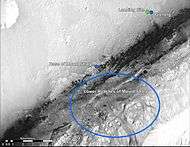
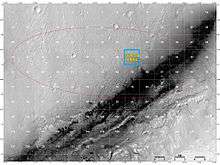 Curiosity's landing ellipse. Quad 51, called Yellowknife, marks the area where Curiosity actually landed.
Curiosity's landing ellipse. Quad 51, called Yellowknife, marks the area where Curiosity actually landed.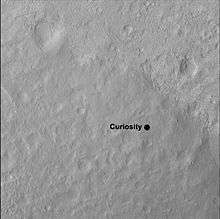 Quad 51, a 1-mile-by-1-mile section of Gale Crater - Curiosity landing site is noted.
Quad 51, a 1-mile-by-1-mile section of Gale Crater - Curiosity landing site is noted.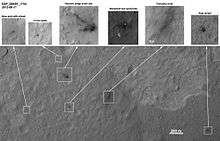 MSL debris field - parachute landed 615 m from Curiosity (3-D: rover & parachute) (August 17, 2012; MRO).
MSL debris field - parachute landed 615 m from Curiosity (3-D: rover & parachute) (August 17, 2012; MRO)._-_HiRISE_-_20120814.jpg)
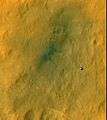

Rover images
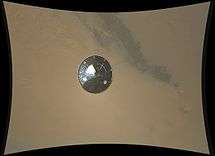 Ejected heat shield as viewed by Curiosity descending to Martian surface (August 6, 2012).
Ejected heat shield as viewed by Curiosity descending to Martian surface (August 6, 2012).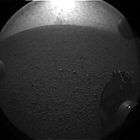 Curiosity's first image after landing (August 6, 2012). The rover's wheel can be seen.
Curiosity's first image after landing (August 6, 2012). The rover's wheel can be seen.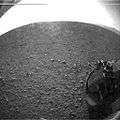 Curiosity's first image after landing (without clear dust cover, August 6, 2012)
Curiosity's first image after landing (without clear dust cover, August 6, 2012)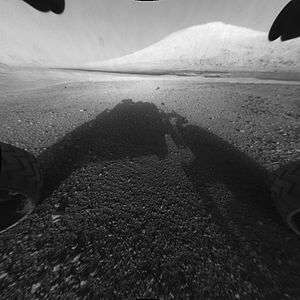 Curiosity landed on August 6, 2012 near the base of Aeolis Mons (or "Mount Sharp")[154]
Curiosity landed on August 6, 2012 near the base of Aeolis Mons (or "Mount Sharp")[154] Curiosity's first color image of the Martian landscape, taken by MAHLI (August 6, 2012)
Curiosity's first color image of the Martian landscape, taken by MAHLI (August 6, 2012)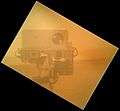 Curiosity's self-portrait - with closed dust cover (September 7, 2012).
Curiosity's self-portrait - with closed dust cover (September 7, 2012).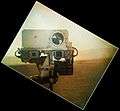 Curiosity's self-portrait (September 7, 2012; color-corrected).
Curiosity's self-portrait (September 7, 2012; color-corrected).

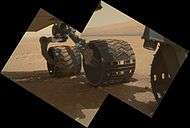
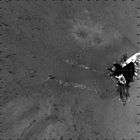 Curiosity's tracks on first test drive (August 22, 2012), after parking 6 m (20 ft) from original landing site[8]
Curiosity's tracks on first test drive (August 22, 2012), after parking 6 m (20 ft) from original landing site[8]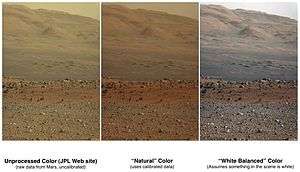 Comparison of color versions (raw, natural, white balance) of Aeolis Mons on Mars (August 23, 2012)
Comparison of color versions (raw, natural, white balance) of Aeolis Mons on Mars (August 23, 2012)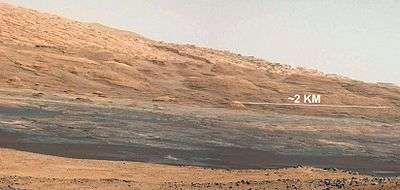
 Layers at the base of Aeolis Mons. The dark rock in inset is the same size as Curiosity.
Layers at the base of Aeolis Mons. The dark rock in inset is the same size as Curiosity.
Self-portraits
Wide images



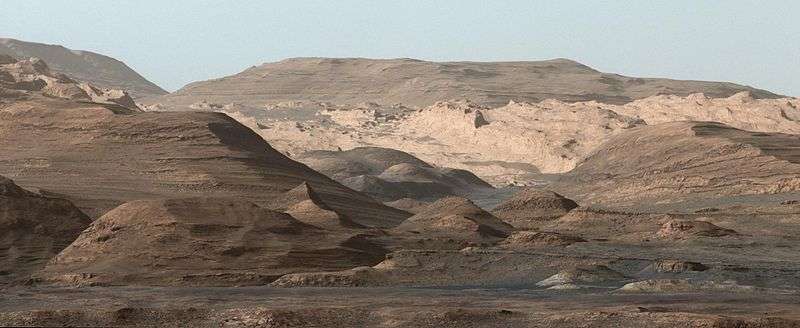
See also
- Timeline of Mars Science Laboratory
- Adam Steltzner
- Anita Sengupta
- Astrobiology
- Autonomous robot
- ExoMars rover
- Experience Curiosity
- Exploration of Mars
- InSight lander
- Life on Mars
- List of missions to Mars
- Mars Express
- Mars Odyssey Orbiter
- Mars Orbiter Mission
- Mars Pathfinder (Sojourner rover)
- Mars Reconnaissance Orbiter
- Mars 2020 rover mission
- Opportunity rover
- Spirit rover
- Viking program
References
- 1 2 Wall, Mike (August 6, 2012). "Touchdown! Huge NASA Rover Lands on Mars". Space.com. Retrieved December 14, 2012.
- ↑ "Rover Fast Facts". NASA.
- 1 2 3 Nelson, Jon. "Mars Science Laboratory Curiosity Rover". NASA. Retrieved February 2, 2014.
- ↑ "Curiosity: NASA's Next Mars Rover". NASA. August 6, 2012. Retrieved August 6, 2012.
- ↑ Beutel, Allard (November 19, 2011). "NASA's Mars Science Laboratory Launch Rescheduled for Nov. 26". NASA. Retrieved November 21, 2011.
- ↑ Martin, Paul K. (June 8, 2011). "NASA'S MANAGEMENT OF THE MARS SCIENCE LABORATORY PROJECT (IG-11-019)" (PDF). NASA Office of Inspector General. Retrieved August 6, 2012.
- ↑ Amos, Jonathan (August 8, 2012). "Nasa's Curiosity rover lifts its navigation cameras". BBC News. Retrieved June 23, 2014.
- 1 2 3 4 Brown, Dwayne; Cole, Steve; Webster, Guy; Agle, D.C. (August 22, 2012). "NASA Mars Rover Begins Driving at Bradbury Landing". NASA. Retrieved August 22, 2012.
- 1 2 "Video from rover looks down on Mars during landing". MSNBC. August 6, 2012. Retrieved October 7, 2012.
- 1 2 Young, Monica (August 7, 2012). "Watch Curiosity Descend onto Mars". SkyandTelescope.com. Retrieved October 7, 2012.
- ↑ "Where is Curiosity?". NASA. Retrieved September 26, 2016.
- ↑ "MSL Sol 3 Update". NASA Television. August 8, 2012. Retrieved August 9, 2012.
- 1 2 "Impressive' Curiosity landing only 1.5 miles off, NASA says". CNN. Retrieved August 10, 2012.
- 1 2 "Overview". JPL, NASA. Retrieved August 16, 2012.
- 1 2 3 "Mars Science Laboratory: Mission Science Goals". NASA.gov. August 2012. Retrieved August 21, 2012.
- ↑ "Curiosity's mission extended indefinitely". 3 News NZ. December 6, 2012.
- ↑ "MSL Objectives". NASA.
- ↑ Phillips, Tony (February 24, 2012). "Curiosity, The Stunt Double". NASA.gov. Retrieved January 26, 2014.
- ↑ Grotzinger, John P. (January 24, 2014). "Habitability, Taphonomy, and the Search for Organic Carbon on Mars". Science. 343 (6169): 386–387. Bibcode:2014Sci...343..386G. doi:10.1126/science.1249944. PMID 24458635.
- 1 2 Watson, Traci (April 14, 2008). "Troubles parallel ambitions in NASA Mars project". USA Today. Retrieved May 27, 2009.
- 1 2 "MSL at a glance - CNES". Cnes.fr. Retrieved August 7, 2012.
- 1 2 3 "Multi-Mission Radioisotope Thermoelectric Generator" (PDF). NASA/JPL. January 1, 2008. Retrieved August 6, 2012.
- 1 2 3 "Mars Exploration: Radioisotope Power and Heating for Mars Surface Exploration" (PDF). NASA/JPL. April 18, 2006. Retrieved September 7, 2009.
- ↑ Clark, Stephen (November 17, 2011). "Nuclear power generator hooked up to Mars rover". Spaceflight Now. Retrieved November 11, 2013.
- ↑ Ritz, Fred; Peterson, Craig E. (2004). Multi-Mission Radioisotope Thermoelectric Generator (MMRTG) Program Overview (PDF). 2004 IEEE Aerospace Conference. March 6–13, 2004. Big Sky, Montana. doi:10.1109/AERO.2004.1368101.
- ↑ Cataldo, Robert L.; Bennett, Gary L. (October 21, 2011). "U.S. Space Radioisotope Power Systems and Applications: Past, Present and Future" (PDF). In Singh, Nirmal. Radioisotopes: Applications in Physical Sciences. InTech. doi:10.5772/23914. ISBN 978-953-307-510-5.
- ↑ Campbell, Joseph (2011). "Fueling the Mars Science Laboratory" (PDF). Idaho National Laboratory.
- ↑ "Technologies of Broad Benefit: Power". Archived from the original on June 14, 2008. Retrieved September 20, 2008.
- ↑ "Mars Science Laboratory – Technologies of Broad Benefit: Power". NASA/JPL. Retrieved April 23, 2011.
- ↑ Misra, Ajay K. (June 26, 2006). "Overview of NASA Program on Development of Radioisotope Power Systems with High Specific Power" (PDF). NASA/JPL. Retrieved May 12, 2009.
- 1 2 3 4 5 6 7 Makovsky, Andre; Ilott, Peter; Taylor, Jim (November 2009). Mars Science Laboratory Telecommunications System Design (PDF). DESCANSO Design and Performance Summary Series. 14. NASA/Jet Propulsion Laboratory.
- 1 2 Watanabe, Susan (August 9, 2009). "Keeping it Cool (...or Warm!)". NASA/JPL. Retrieved January 19, 2011.
- 1 2 3 4 5 "Mars Science Laboratory: Mission: Rover: Brains". NASA/JPL. Retrieved March 27, 2009.
- ↑ Bajracharya, Max; Maimone, Mark W.; Helmick, Daniel (December 2008). "Autonomy for Mars rovers: past, present, and future". Computer. 41 (12): 45. doi:10.1109/MC.2008.515. ISSN 0018-9162.
- ↑ "BAE Systems Computers to Manage Data Processing and Command For Upcoming Satellite Missions" (Press release). BAE Systems. June 17, 2008. Archived from the original on June 17, 2008. Retrieved November 17, 2008.
- ↑ "E&ISNow — Media gets closer look at Manassas" (PDF). BAE Systems. August 1, 2008. Archived from the original (PDF) on December 17, 2008. Retrieved November 17, 2008.
- ↑ "RAD750 radiation-hardened PowerPC microprocessor" (PDF). BAE Systems. July 1, 2008. Retrieved September 7, 2009.
- ↑ "RAD6000 Space Computers" (PDF). BAE Systems. June 23, 2008. Archived from the original (PDF) on October 4, 2009. Retrieved September 7, 2009.
- ↑ Webster, Guy (March 4, 2013). "Curiosity Rover's Recovery on Track". NASA. Retrieved March 5, 2013.
- ↑ Webster, Guy (March 25, 2013). "Curiosity Resumes Science Investigations". NASA. Retrieved March 27, 2013.
- ↑ "Mars-Earth distance in light minutes". WolframAlpha. Retrieved August 6, 2012.
- ↑ "Curiosity's data communication with Earth". NASA. Retrieved August 7, 2012.
- ↑ "NASA's Curiosity Rover Maximizes Data Sent to Earth by Using International Space Data Communication Standards".
- ↑ "ESA spacecraft records crucial NASA signals from Mars". Mars Daily. August 7, 2012. Retrieved August 8, 2012.
- ↑ "Next Mars Rover Sports a Set of New Wheels". NASA/JPL.
- ↑ "Watch NASA's Next Mars Rover Being Built Via Live 'Curiosity Cam'". NASA. September 13, 2011. Retrieved August 16, 2012.
- ↑ "New Mars Rover to Feature Morse Code". National Association for Amateur Radio.
- ↑ Marlow, Jeffrey (August 29, 2012). "Looking Toward the Open Road". JPL - Martian Diaries. NASA. Retrieved August 30, 2012.
- ↑ Lakdawalla, Emily (August 19, 2014). "Curiosity wheel damage: The problem and solutions". The Planetary Society Blogs. The Planetary Society. Retrieved August 22, 2014.
- 1 2 3 "Mars Science Laboratory - Facts" (PDF). Jet Propulsion Laboratory, NASA. March 2012. Retrieved July 31, 2012.
- ↑ "First drive".
- ↑ Gorman, Steve (August 8, 2011). "Curiosity beams Mars images back". Stuff - Science. Retrieved August 8, 2012.
- 1 2 "Mars Science Laboratory". NASA.
- ↑ Amos, Jonathan (August 3, 2012). "Gale Crater: Geological 'sweet shop' awaits Mars rover". BBC News. Retrieved August 6, 2012.
- 1 2 3 "MSL Science Corner: Sample Analysis at Mars (SAM)". NASA/JPL. Retrieved September 9, 2009.
- ↑ "Overview of the SAM instrument suite". NASA. Archived from the original on February 22, 2007.
- ↑ Malin, M. C.; Bell, J. F.; Cameron, J.; Dietrich, W. E.; Edgett, K. S.; et al. (2005). The Mast Cameras and Mars Descent Imager (MARDI) for the 2009 Mars Science Laboratory (PDF). Lunar and Planetary Science XXXVI. p. 1214. Bibcode:2005LPI....36.1214M.
- 1 2 3 4 5 "Mast Camera (MastCam)". NASA/JPL. Retrieved March 18, 2009.
- 1 2 3 "Mars Hand Lens Imager (MAHLI)". NASA/JPL. Retrieved March 23, 2009.
- 1 2 3 "Mars Descent Imager (MARDI)". NASA/JPL. Retrieved April 3, 2009.
- 1 2 3 "Mars Science Laboratory (MSL): Mast Camera (MastCam): Instrument Description". Malin Space Science Systems. Retrieved April 19, 2009.
- ↑ Stern, Alan; Green, Jim (November 8, 2007). "Mars Science Laboratory Instrumentation Announcement from Alan Stern and Jim Green, NASA Headquarters". SpaceRef.com. Retrieved August 6, 2012.
- ↑ Mann, Adam (August 7, 2012). "The Photo-Geek's Guide to Curiosity Rover's 17 Cameras". Wired. Retrieved January 16, 2015.
- ↑ Klinger, Dave (August 7, 2012). "Curiosity says good morning from Mars (and has busy days ahead)". Ars Technica. Retrieved January 16, 2015.
- ↑ "Mars Science Laboratory (MSL) Mast Camera (MastCam)". Malin Space Science Systems. Retrieved August 6, 2012.
- ↑ David, Leonard (March 28, 2011). "NASA Nixes 3-D Camera for Next Mars Rover". Space.com. Retrieved August 6, 2012.
- ↑ Bell III, J. F.; Maki, J. N.; Mehall, G. L.; Ravine, M. A.; Caplinger, M. A. (2014). Mastcam-Z: A Geologic, Stereoscopic, and Multispectral Investigation on the NASA Mars-2020 Rover (PDF). International Workshop on Instrumentation for Planetary Missions. November 4–7, 2014. Greenbelt, Maryland.
- 1 2 3 4 "MSL Science Corner: Chemistry & Camera (ChemCam)". NASA/JPL. Retrieved September 9, 2009.
- ↑ Salle, B.; Lacour, J. L.; Mauchien, P.; Fichet, P.; Maurice, S.; et al. (2006). "Comparative study of different methodologies for quantitative rock analysis by Laser-Induced Breakdown Spectroscopy in a simulated Martian atmosphere" (PDF). Spectrochimica Acta Part B-Atomic Spectroscopy. 61 (3): 301–313. Bibcode:2006AcSpe..61..301S. doi:10.1016/j.sab.2006.02.003.
- ↑ Wiens, R.C.; Maurice, S.; Engel, A; Fabry, V. J.; Hutchins, D. A.; et al. (2008). "Corrections and Clarifications, News of the Week". Science. 322 (5907): 1466. doi:10.1126/science.322.5907.1466a.
- ↑ "ChemCam Status". Los Alamos National Laboratory. April 2008.
- ↑ "Spacecraft: Surface Operations Configuration: Science Instruments: ChemCam". Archived from the original on October 2, 2006.
- ↑ Vieru, Tudor (December 6, 2013). "Curiosity's Laser Reaches 100,000 Firings on Mars". Softpedia. Retrieved January 16, 2015.
- ↑ "Rover's Laser Instrument Zaps First Martian Rock.". 2012. Retrieved August 20, 2012.
- ↑ Webster, Guy; Agle, D.C. (August 19, 2012). "Mars Science Laboratory/Curiosity Mission Status Report". NASA. Retrieved September 3, 2012.
- ↑ "'Coronation' Rock on Mars". NASA. Retrieved September 3, 2012.
- ↑ Amos, Jonathan (August 17, 2012). "Nasa's Curiosity rover prepares to zap Martian rocks". BBC News. Retrieved September 3, 2012.
- ↑ "How Does ChemCam Work?". ChemCam Team. 2011. Retrieved August 20, 2012.
- 1 2 "Mars Science Laboratory Rover in the JPL Mars Yard". NASA/JPL. Retrieved May 10, 2009.
- ↑ "First NavCam mosaic".
- ↑ "Rover Environmental Monitoring Station for MSL mission" (PDF). 4th International workshop on the Mars Atmosphere: modelling and observations. Pierre und Marie Curie University. February 2011. Retrieved August 6, 2012.
- 1 2 "MSL Science Corner: Rover Environmental Monitoring Station (REMS)". NASA/JPL. Retrieved September 9, 2009.
- ↑ "Mars Science Laboratory Fact Sheet" (PDF). NASA/JPL. Retrieved June 20, 2011.
- 1 2 3 4 5 "Mars Science Laboratory: Mission: Rover: Eyes and Other Senses: Four Engineering Hazcams (Hazard Avoidance Cameras)". NASA/JPL. Retrieved April 4, 2009.
- ↑ Edgett, Kenneth S. "Mars Hand Lens Imager (MAHLI)". NASA. Retrieved January 11, 2012.
- ↑ "3D View of MAHLI Calibration Target". NASA. September 13, 2012. Retrieved October 11, 2012.
- 1 2 3 "MSL Science Corner: Alpha Particle X-ray Spectrometer (APXS)". NASA/JPL. Retrieved September 9, 2009.
- ↑ "40th Lunar and Planetary Science Conference" (PDF). 2009.
"41st Lunar and Planetary Science Conference" (PDF). 2010. - ↑ Rieder, R.; Gellert, R.; Brückner, J.; Klingelhöfer, G.; Dreibus, G.; et al. (2003). "The new Athena alpha particle X-ray spectrometer for the Mars Exploration Rovers". Journal of Geophysical Research. 108: 8066. Bibcode:2003JGRE..108.8066R. doi:10.1029/2003JE002150.
- 1 2 Brown, Dwayne (October 30, 2012). "NASA Rover's First Soil Studies Help Fingerprint Martian Minerals". NASA. Retrieved October 31, 2012.
- ↑ "MSL Chemistry & Mineralogy X-ray diffraction(CheMin)". NASA/JPL. Retrieved November 25, 2011.
- ↑ Sarrazin, P.; Blake, D.; Feldman, S.; Chipera, S.; Vaniman, D.; et al. (2005). "Field deployment of a portable X-ray diffraction/X-ray fluorescence instrument on Mars analog terrain". Powder Diffraction. 20 (2): 128–133. Bibcode:2005PDiff..20..128S. doi:10.1154/1.1913719.
- ↑ Hoover, Rachel (June 24, 2014). "Ames Instrument Helps Identify the First Habitable Environment on Mars, Wins Invention Award". NASA. Retrieved June 25, 2014.
- ↑ Anderson, Robert C.; Baker, Charles J.; Barry, Robert; Blake, David F.; Conrad, Pamela; et al. (December 14, 2010). "Mars Science Laboratory Participating Scientists Program Proposal Information Package" (PDF). NASA/Jet Propulsion Laboratory. Retrieved January 16, 2015.
- ↑ Beegle, L. W.; Peters, G. H.; Mungas, G. S.; Bearman, G. H.; Smith, J. A.; et al. (2007). Mojave Martian Simulant: A New Martian Soil Simulant (PDF). Lunar and Planetary Science XXXVIII. Retrieved April 28, 2014.
- ↑ Allen, C. C.; Morris, R. V.; Lindstrom, D. J.; Lindstrom, M. M.; Lockwood, J. P. (March 1997). JSC Mars-1: Martian regolith simulant (PDF). Lunar and Planetary Exploration XXVIII. Retrieved April 28, 2014.
- ↑ Cabane, M.; Coll, P.; Szopa, C.; Israël, G.; Raulin, F.; et al. (2004). "Did life exist on Mars? Search for organic and inorganic signatures, one of the goals for "SAM" (sample analysis at Mars)" (PDF). Advances in Space Research. 33 (12): 2240–2245. Bibcode:2004AdSpR..33.2240C. doi:10.1016/S0273-1177(03)00523-4.
- 1 2 "Sample Analysis at Mars (SAM) Instrument Suite". NASA. October 2008. Retrieved October 9, 2009.
- ↑ Tenenbaum, D. (June 9, 2008). "Making Sense of Mars Methane". Astrobiology Magazine. Retrieved October 8, 2008.
- ↑ Tarsitano, C. G.; Webster, C. R. (2007). "Multilaser Herriott cell for planetary tunable laser spectrometers". Applied Optics. 46 (28): 6923–6935. Bibcode:2007ApOpt..46.6923T. doi:10.1364/AO.46.006923. PMID 17906720.
- ↑ Mahaffy, Paul R.; Webster, Christopher R.; Cabane, Michel; Conrad, Pamela G.; Coll, Patrice; et al. (2012). "The Sample Analysis at Mars Investigation and Instrument Suite". Space Science Reviews. 170: 401–478. Bibcode:2012SSRv..tmp...23M. doi:10.1007/s11214-012-9879-z.
- ↑ Moskowitz, Clara (January 7, 2013). "NASA's Curiosity Rover Brushes Mars Rock Clean, a First". Space.com. Retrieved January 16, 2015.
- 1 2 "SwRI Radiation Assessment Detector (RAD) Homepage". Southwest Research Institute. Retrieved January 19, 2011.
- ↑ "RAD". NASA.
- ↑ "Laboratory for Space Gamma Spectroscopy - DAN". Laboratory for Space Gamma Spectroscopy. Retrieved September 20, 2012.
- ↑ "MSL Science Corner: Dynamic Albedo of Neutrons (DAN)". NASA/JPL. Retrieved September 9, 2009.
- ↑ Litvak, M. L.; Mitrofanov, I. G.; Barmakov, Yu. N.; Behar, A.; Bitulev, A.; et al. (2008). "The Dynamic Albedo of Neutrons (DAN) Experiment for NASA's 2009 Mars Science Laboratory". Astrobiology. 8 (3): 605–12. Bibcode:2008AsBio...8..605L. doi:10.1089/ast.2007.0157. PMID 18598140.
- ↑ "Mars Science Laboratory: Mission". NASA JPL. Retrieved August 6, 2012.
- ↑ "Mars Descent Imager (MARDI) Update". Malin Space Science Systems. November 12, 2007. Retrieved August 6, 2012.
- ↑ "Junocam, Juno Jupiter Orbiter". Malin Space Science Systems. Retrieved August 6, 2012.
- ↑ Anderson, Paul Scott (February 3, 2013). "Curiosity 'hammers' a rock and completes first drilling tests". themeridianijournal.com. Retrieved February 3, 2013.
- 1 2 "Curiosity Rover - Arm and Hand". JPL. NASA. Retrieved August 21, 2012.
- 1 2 3 Jandura, Louise. "Mars Science Laboratory Sample Acquisition, Sample Processing and Handling: Subsystem Design and Test Challenges" (PDF). JPL. NASA. Retrieved August 21, 2012.
- 1 2 "Curiosity Stretches its Arm". JPL. NASA. August 21, 2012. Retrieved August 21, 2012.
- ↑ http://www.mdacorp-us.com/Robotics%20Papers/rbilling%20%28final%20copy%20sent%20to%20ESMATS%29.pdf
- 1 2 "MSL Participating Scientists Program - Proposal Information Package" (PDF). Washington University. December 14, 2010. Retrieved August 21, 2012.
- ↑ Billing, Rius; Fleischner, Richard (2011). "Mars Science Laboratory Robotic Arm" (PDF). 15th European Space Mechanisms and Tribology Symposium 2011. Retrieved August 21, 2012.
- ↑ Mars Rovers: Pathfinder, MER (Spirit and Opportunity), and MSL (video). Pasadena, California. April 12, 2008. Retrieved September 22, 2011.
- ↑ "Mars Exploration Rover Launches" (PDF). NASA. June 2003. Archived (PDF) from the original on July 26, 2004.
- ↑ "PIA16068". NASA.
- ↑ "PIA15987". NASA.
- 1 2 "Watching Curiosity on Mars makes me feel like athlete who didn't win a medal". The Sun. August 8, 2012.
- ↑ Clark, Stuart (January 17, 2015). "Beagle 2 spacecraft found intact on surface of Mars after 11 years". The Guardian. Retrieved January 18, 2015.
- ↑ Gibson, E. K.; Pillinger, C. T.; Wright, I. P.; Hurst, S. J.; Richter, L.; et al. (2012). "How do you answer the life on Mars question? Use multiple small landers like Beagle 2" (PDF). Concepts and Approaches for Mars Exploration.
- ↑ "Curiosity's Quad - IMAGE". NASA. August 10, 2012. Retrieved August 11, 2012.
- ↑ Agle, DC; Webster, Guy; Brown, Dwayne (August 9, 2012). "NASA's Curiosity Beams Back a Color 360 of Gale Crate". NASA. Retrieved August 11, 2012.
- ↑ Amos, Jonathan (August 9, 2012). "Mars rover makes first colour panorama". BBC News. Retrieved August 9, 2012.
- ↑ Halvorson, Todd (August 9, 2012). "Quad 51: Name of Mars base evokes rich parallels on Earth". USA Today. Retrieved August 12, 2012.
- ↑ Hand, Eric (August 3, 2012). "Crater mound a prize and puzzle for Mars rover". Nature. Retrieved August 6, 2012.
- ↑ "Gale Crater's History Book". Mars Odyssey THEMIS. Retrieved August 6, 2012.
- ↑ Chang, Kenneth (October 5, 2015). "Mars Is Pretty Clean. Her Job at NASA Is to Keep It That Way.". The New York Times. Retrieved October 6, 2015.
- ↑ "Why NASA's Mars Curiosity Rover landing will be "Seven Minutes of Absolute Terror"". NASA. Centre National d'Etudes Spatiales (CNES). June 28, 2012. Retrieved July 13, 2012.
- ↑ "Final Minutes of Curiosity's Arrival at Mars". NASA/JPL. Retrieved April 8, 2011.
- ↑ Teitel, Amy Shira (November 28, 2011). "Sky Crane – how to land Curiosity on the surface of Mars". Scientific American. Retrieved August 6, 2012.
- ↑ Snider, Mike (July 17, 2012). "Mars rover lands on Xbox Live". USA Today. Retrieved July 27, 2012.
- ↑ "Mars Science Laboratory: Entry, Descent, and Landing System Performance" (PDF). NASA. March 2006. p. 7.
- ↑ Amos, Jonathan (June 12, 2012). "NASA's Curiosity rover targets smaller landing zone". BBC News. Retrieved June 12, 2012.
- 1 2 Chang, Kenneth (August 13, 2012). "Mars Looks Quite Familiar, if Only on the Surface". New York Times. Retrieved August 14, 2012.
- ↑ "Curiosity Lands on Mars". NASA TV. Retrieved August 6, 2012.
- ↑ "NASA's Mars Rover Crashed Into a DMCA Takedown". Motherboard. Motherboard.vice.com. August 6, 2012. Retrieved August 8, 2012.
- ↑ "Huge Crowds Watched NASA Rover Land on Mars from NYC's Times Square". Space.com. Retrieved August 8, 2012.
- ↑ "Mars Rover 'Mohawk Guy' a Space Age Internet Sensation | Curiosity Rover". Space.com. August 7, 2012. Retrieved August 8, 2012.
- ↑ "Mars landing proves memes now travel faster than the speed of light (gallery)". VentureBeat. June 18, 2012. Retrieved August 8, 2012.
- ↑ "inXitu Press Release" (PDF). InXitu. March 10, 2011. Archived from the original (PDF) on August 3, 2012. Retrieved August 13, 2012.
- ↑ "Martian rover tech has an eye for priceless works of art". August 10, 2012. Retrieved August 13, 2012.
- ↑ Thomen, Daryl (August 6, 2012). "'Mars Rover Landing' with Kinect for the Xbox 360". Newsday. Retrieved August 8, 2012.
- ↑ "Send Your Name to Mars". NASA. 2010. Retrieved August 7, 2012.
- ↑ "NASA's Curiosity rover flying to Mars with Obama's, others' autographs on board". Retrieved August 11, 2012.
- ↑ Dewey, Caitlin (August 6, 2013). "Lonely Curiosity rover sings 'Happy Birthday' to itself on Mars". Washington Post. Retrieved August 7, 2013.
- ↑ Webster, Guy; Brown, Dwayne (June 23, 2014). "NASA's Mars Curiosity Rover Marks First Martian Year". NASA. Retrieved June 23, 2014.
- ↑ Harwood, William (December 4, 2012). "NASA announces plans for new $1.5 billion Mars rover". CNET. Retrieved December 5, 2012.
Using spare parts and mission plans developed for NASA's Curiosity Mars rover, the space agency says it can build and launch a new rover in 2020 and stay within current budget guidelines.
- ↑ Bosco, Cassandro (March 12, 2013). "NASA/JPL Mars Curiosity Project Team Receive 2012 Robert J. Collier Trophy" (PDF). National Aeronautic Association. Retrieved February 9, 2014.
- 1 2 Williams, John (August 15, 2012). "A 360-degree 'street view' from Mars". PhysOrg. Retrieved August 16, 2012.
- ↑ Bodrov, Andrew (September 14, 2012). "Mars Panorama - Curiosity rover: Martian solar day 2". 360Cities. Retrieved September 14, 2012.
External links
| Look up Curiosity in Wiktionary, the free dictionary. |
| Wikimedia Commons has media related to Curiosity rover. |
| Wikimedia Commons has media related to Photos by the Curiosity rover. |
- Curiosity Rover - Home Page - NASA/JPL
- MSL - NASA Updates - *LIVE* TBA Schedule (NASA-TV) (NASA-Audio)
- The search for life on Mars & elsewhere in the Solar System: Curiosity update - Video lecture by Christopher P. McKay
- MSL - NASA Updates - *REPLAY* Anytime (NASA-YouTube) (NASA-Ustream)
- MSL - Curiosity Design and Mars Landing - PBS Nova (2012-11-14) - Video (53:06)
- MSL - "Curiosity 'StreetView'" (Sol 2 - 2012-08-08) - NASA/JPL - 360° Panorama
- MSL - "Curiosity Lands" (2012-08-06) - NASA/JPL - Video (03:40)
- MSL - "Curiosity Descent" (2012-08-21) (sim&real/narrated) - Video (04:06)
- MSL - "Curiosity Descent" (2012-08-06) (real time/25fps) - Video (01:57)
- MSL - "Curiosity Descent" (2012-08-06) (all/4fps) - NASA/JPL - Video (03:04)
- MSL - Landing ("7 Minutes of Terror") - NASA/JPL - Video (05:08)
- MSL - Landing (EDL/EntryDescentLanding) - Animated Video (02:00)
- MSL - Landing Site - Gale Crater - Animated/Narrated Video (02:37)
- MSL - Landing Site - Gale Crater - Google Mars (zoomable map)
- MSL - Curiosity Rover - Learn About Curiosity - NASA/JPL
- MSL - Curiosity Rover - Virtual Tour - NASA/JPL
- MSL - NASA Image Gallery
- Weather Reports from the Rover Environmental Monitoring Station (REMS)
- Curiosity on Twitter

- MSL - NASA Update - AGU Conference (2012-12-03) Video (70:13)
- Panorama (via Universe Today)
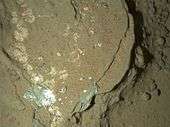
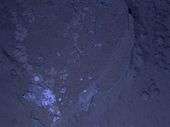
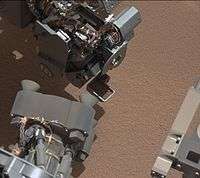


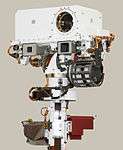
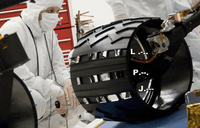

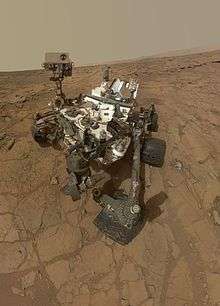
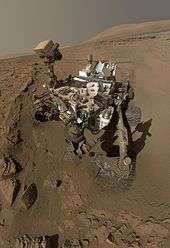

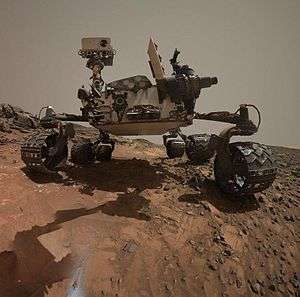


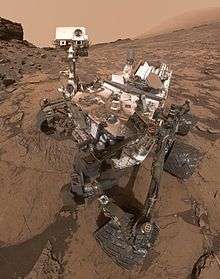


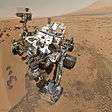


.jpg)
.jpg)
